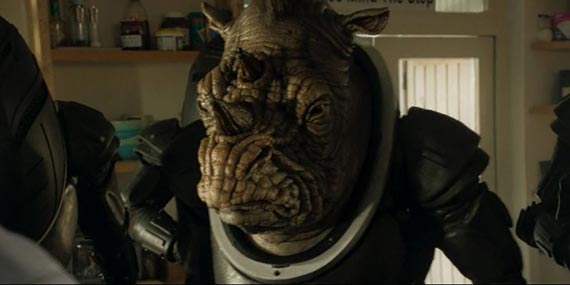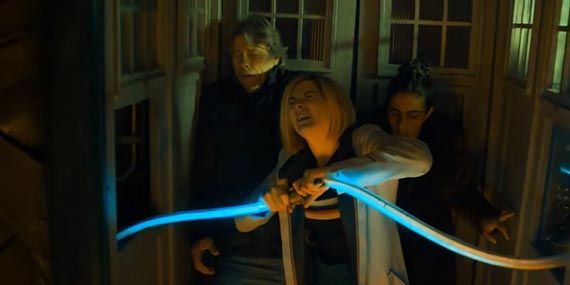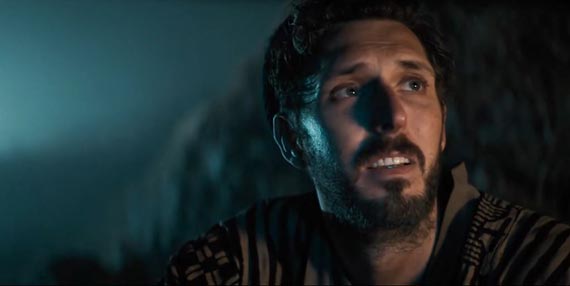Doctor Who: Flux “Chapter Four: Village of the Angels” Review – “Diminishing Returns”
Clint Hassell gives his SPOILER-filled commentary on the fourth episode of Series 13.

Note: this review contains full SPOILERS for episode 4 of Series 13.
After last week’s detour into the relative time streams of its central characters, Doctor Who: Flux struggles to return to form with an episode that stresses style over substance, providing ample scares but little character development or answers to Flux’s ongoing mysteries.
“Chapter Four: Village of the Angels” is most hampered by its central threat: the titular Weeping Angels. Undoubtedly, the debut of these “lonely assassins,” in Series 3’s “Blink,” is an instant classic and deserving of all the praise it garners; however, beyond this one, perfect episode, the Angels have never been used to their full advantage. Rather, writers continue to include the Angels in stories that are not ideally suited for the narrative challenges inherent to a monster that cannot move when observed.
The Weeping Angels are unique because their threat is existential. Victims aren’t devoured, they are instantly and irrevocably separated from their loved ones, their belongings, and all modern conveniences. How does one begin to start over, with no resources? It’s a fate as tragic as death, yet somehow more macabre, due to the awareness of what has been lost. This concept takes time to establish, and “Blink” devoted a large part of its moody, atmospheric narrative to exploring this idea. Flux, with its myriad of plot threads, characters, and reveals, doesn’t have time to dissect the particular horrors of being displaced in time, thus stripping the storyline of one of the Angels’ defining features: the novel way they prey on their victims.

Further, as Flux’s central storyline is intrinsically tied to resolving the Doctor’s time with the Division – – memories to which the rogue Angel claims to be privy – – the plot of “Chapter Four” requires the Angels to talk. How does one converse with an immobile villain? The episode utilizes three different techniques: the Angel living inside the possessed Claire communicates through her, Peggy claims that the Weeping Angels “put thoughts inside [her] head,” and the invading Angels speak through Professor Jericho’s television. None of this is necessarily contrary to canon – – the Angels spoke through Cleric Bob, in “The Time of Angels”/“Flesh and Stone” – – but it undercuts the uniqueness of the normally silent statues.
At their best, the Weeping Angels exist only to feed. They are like the velociraptors from Jurassic Park. Forcing the Angels to have motives beyond survival necessitates contrived plot devices in order to understand their actions and move them through the storyline. It’s unfair to blame showrunner Chris Chibnall for these inane plot points, as former showrunner Steven Moffat started changing the nature of the Angels in their second appearance. However, Chibnall’s script not only emphasizes the worst additions to the Angels’ mythology, it expands upon them. Mere dust (or possibly the reflection of the Angel in Professor Jericho’s eye – – the visuals of this particular effect make it difficult to determine) is enough to shunt him backwards through time. Victims crumble into dust, when touched a second time by an Angel, undercutting the concept of a battery that was established in “The Angels Take Manhattan.” Ripped pieces of Claire’s Angel drawing reconstitute themselves, as if by enchantment, so that the sketch can serve as a gateway for an invading Angel. It’s an unfortunate case of diminishing returns: to capitalize on the popularity of the Angels, they are included in new episodes, but each adventure adds unnecessary contrivances to the mythology, further diluting the uniqueness that makes them popular.
The issue with the Weeping Angels is not that it is difficult to write them well, it’s that it is so easy to write them poorly. The story logic governing the Angels isn’t based in any sort of science – – even Who-esque pseudo-science – – and lacks internal consistency, instead allowing for whatever is necessitated by the plot. This is the definition of magic, and its inclusion pushes Who’s narrative out of the realm of science fiction and into the realm of fantasy. Honestly, that’s where some of Doctor Who’s worst episodes lie, including “Fear Her” and “Kill the Moon.”

“Diminishing returns” can also be used to describe Flux as a whole. It feels like the serial doesn’t understand that each episode needs to contribute to the overall storyline, while also being enjoyable unto itself. In an engaging serial, every chapter has a goal for the characters to achieve, with each episode building upon the previous towards the climax of the story. In “The Dead Planet,” the first chapter of the classic Doctor Who serial The Daleks, the Doctor and his companions explore an alien city and encounter the Daleks for the first time. In episode two, Ian, Barbara, Susan, and the Doctor are captured and begin to suffer from radiation sickness. They escape confinement in episode three, and flee the Dalek city in episode four, but not before the peaceful Thals are ambushed by the Daleks. Each chapter of the serial is engaging on its own, with episode five and six respectively featuring Ian and Barbara traversing a swamp and a cave system, while also providing more information about the Dalek race and their war with the Thals. While the second chapter of Flux, “War of the Sontarans,” did a remarkable job of telling a complete story while also furthering the overarching narrative, “Village of the Angels” is the second episode in a row that cannot be appreciated in isolation.
In fact, there are only two episodes of Flux remaining, and the Doctor and her companions still don’t know what the Flux does, who caused it, or how most of the characters in this storyline are involved. Rather than connecting the seemingly disparate pieces of Series 13’s puzzling plot together, the narrative continues to dump more pieces onto the table. Certainly, it is possible for Flux’s various storylines to come together, in the finale, and to withstand scrutiny, once the entire picture is complete (and, yes, there is a certain inherent unfairness to reviewing a serial in pieces). However, at this point, the serial feels directionless, the number of unresolved plot points almost certainly necessitating an exposition-laden finale, resulting in a conclusion that feels more revealed than earned.
Random Musings:


(Time) Capsule Review
Disappointing in isolation, though effectively steeped in scares, “Village of the Angels” fails to develop its cast of characters or further any of Flux’s ongoing mysteries. Rather than utilizing the Judoon – – monsters already tied to the Division who also have a motive to capture the Doctor – – the episode features the fan-favorite Weeping Angels in a plot that requires too much exposition and contrivance to suit the silent, immobile “lonely assassins.” This demonstrates a lack of understanding of the Angels as a narrative device and reduces the episode to a standard “base under siege” adventure. With two episodes remaining, Flux needs not to have answered the “who?” or “why?” questions, but should’ve at least addressed the “what?” and “how?” queries. Lacking this, Doctor Who: Flux feels unaware of its own serialized nature, and hints at an exposition-laden finale.
If you’d like to interact with the author of this article, follow him on Twitter @ClintHassell.








